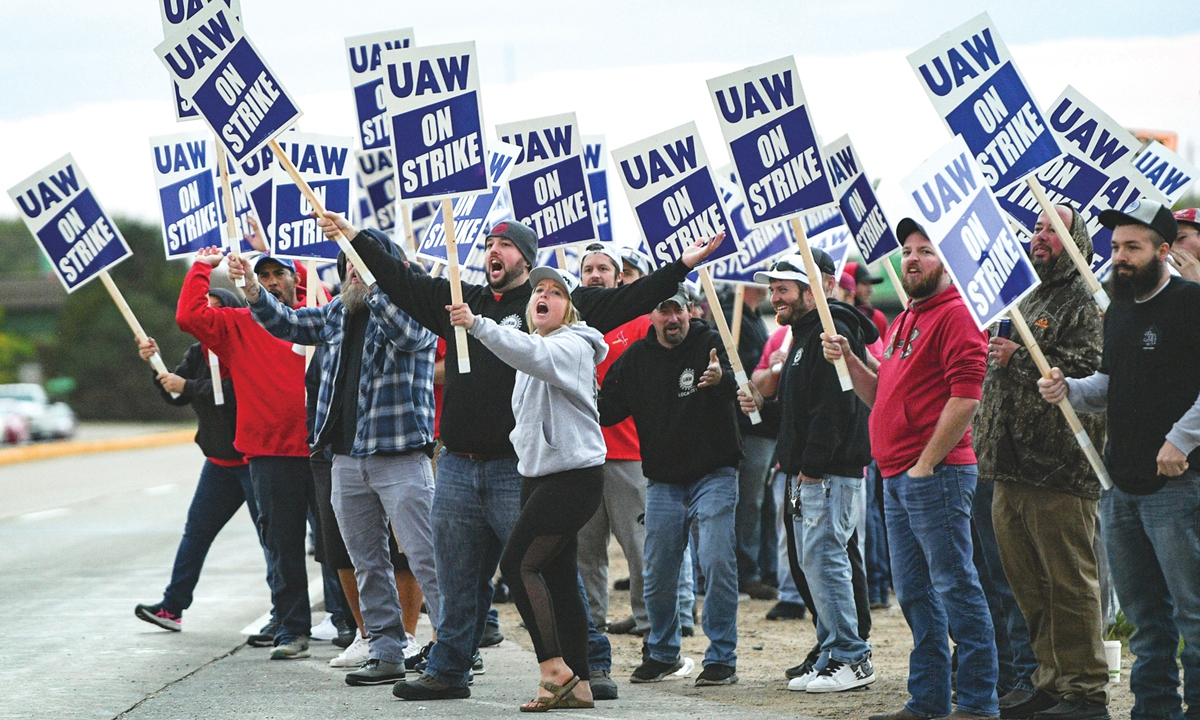
Deere & Co employees go on strike on October 14, 2021, in Davenport, Iowa. Photo: AP
American workers are fed up. From Deere & Co's factories and Kellogg Co's US cereal plants to Alabama coal miners and Massachusetts nurses, tens of thousands of workers across a vast swath of industries are going on, or preparing for, strikes across the country. Contagion of workouts in the US has led some to dub this October "Striketober." Many netizens voiced their support for the work stoppages against current working conditions using the hashtag #Striketober. Meanwhile, union officials and economists reached by Bloomberg called the trend an offshoot of the phenomenon known as the Great Resignation, worrying it would further thin US labor pool and slow the economic recovery.Workers' anger
"America is a rich country that treats many of its workers remarkably badly," said Paul Krugman, winner of the 2008 Nobel Memorial Prize in Economic Sciences, in his recent column for the New York Times.
Indeed, American workers have been in a long-suffering position in both history and modern times. For decades, US workers have been underpaid and overworked, grappling with wage stagnation.
The pandemic has further worsened American workers' situation. They are risking their lives to go back to work amid the still ravaging COVID-19 in the US because of the US government's botched response, but they haven't seen corresponding increase in salary and other forms of compensation they deserve.
Instead, they have had to work in worsening working conditions with little rewarding. According to the Time magazine, Kellogg workers at a plant in Battle Creek Michigan said they were lauded as heroes for working 16 hours a day and seven days a week during the pandemic, but never received a reward. Kellogg's business has boomed during the COVID-19 lockdown. Steve Cahillane, Kellogg's CEO, took home more than $11.6 million last year, but workers didn't get any share of those increased profits.
American workers are also grappling with increasing overall cost of living. The Wall Street Journal reported on October 13 that the US inflation accelerated in September and remained at its highest rate in over a decade, with price increases from pandemic-related labor and materials shortages rippling through the economy. On a monthly basis, the Consumer Price Index rose a seasonally adjusted 0.4 percent in September from August. This was also faster than in August, which saw a rise of 0.3 percent. American workers are facing high COVID-19 infections and death rates, but cannot afford housing or healthcare. For them, enough is enough.
More importantly, American strikers are fighting against unequal gains. Americans' discontent with growing inequality has galvanized a labor movement.
Over the decades, in sharp contrast to workers' stagnant wages, the wealth of a growing number of billionaires in America has been skyrocketing. Inequality has become more pronounced during the pandemic. American billionaires added $1.8 trillion to their fortunes during the pandemic, according to a report from the Institute for Policy Studies and Americans for Tax Fairness. In 2020, CEOs got paid 351 times more than a typical American worker, an analysis from the Economic Policy Institute found.
Strike, the only mean
Strikes are usually a culmination of existing dissatisfactions, grievances and anger that compound over time. When life gets harder and harder, workers have no other choice but to go on strike to express their discontent and anger. Throughout US history, strikes have been a common sight in almost every sector. They usually see tough and long-lasting battling between the corporate management and unions that represent the laborers. But because of the asymmetry strength between the capitalists and the laborers, strikers' demands could often not be satisfied. Most of the top five biggest strikes in US history ended with failures.

Source: foxbusiness.com Graphics: GT
These most recent walkouts have not come close to those strikes that make up the top 10 biggest in the US history in terms of scale. But a prominent feature of this wave of strikes is that it has spread across almost all walks of life. Nearly 40 workplaces across the US have gone on strike since August 1. According to Bloomberg Law's database of work stoppages, this almost doubles the number occurred during the same period in 2020.The hardships of the low-income groups in the US are obvious to see. In other words, it's no exaggeration to say the bottom 50 percent of Americans are living a hard and unsatisfactory life. "This has laid bare the failure of the US governance," Zhang Tengjun, deputy director of the Department for Asia-Pacific Studies at the China Institute of International Studies, told the Global Times. For one thing, it has demonstrated the growing US inequality. For the other, it reflects the US government's inaction and responsibilities-shirking in terms of narrowing inequality and helping the low-income Americans to have a better life, Zhang noted.
Observers believe that this round of strikes may end with some possible small concessions from the management, but it cannot resolve the long-accumulated US labor-capital conflicts. Nor can it touch the growing gap between the rich and poor. Through walkouts, workers may manage to get a slight improvement in their work conditions, but it is difficult for them to have major progressive changes.
In the US, strikes are organized through labor unions instead of political parties. Therefore, it's hard for workers' appeals to transform into public policy demands. During strikes, if workers could make a noise that is loud enough, after the limited bargaining between the unions and capitalists, the latter may make limited concessions, but then what? Workers will continue to be exploited and suffer from social inequalities.
The US' political division, and its ruling elites' long-term exploitation and neglect of the bottom groups have caused workers to have inferior and unfair positions in society. "Given US institutional flaws and lack of will for reforms to address inequalities, the US will inevitably see bigger inner crises, and the decline of the country is irreversible," said Xu Liang, an associate professor at the School of International Relations, Beijing International Studies University.
"While the US is still plagued by a greater crisis, China may have successfully narrowed the gap between the rich and poor by sticking to the path of common prosperity and set an example for the world. By then, the US being surpassed by China will be inevitable," Xu said.
The author is a reporter with the Global Times. opinion@globaltimes.com.cn

